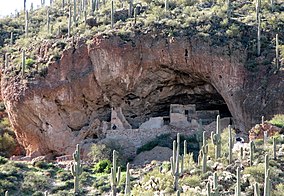Tonto National Monument
| Tonto National Monument | |
|---|---|
|
IUCN category V (protected landscape/seascape)
|
|

Lower Cliff Dwelling
|
|
| Location | Gila County, Arizona, USA |
| Nearest city | Globe, Arizona |
| Coordinates | 33°39′25″N 111°5′40″W / 33.65694°N 111.09444°WCoordinates: 33°39′25″N 111°5′40″W / 33.65694°N 111.09444°W |
| Area | 1,120 acres (4.5 km2) |
| Created | October 21, 1907 |
| Visitors | 53,426 (in 2011) |
| Governing body | National Park Service |
| Website | Tonto National Monument |
Tonto National Monument is a National Monument in the Superstition Mountains, in Gila County of central Arizona. The area lies on the northeastern edge of the Sonoran Desert ecoregion, an arid habitat with annual rainfall of about 16 inches (400 mm) here. The Salt River runs through this area, providing a rare, year-round source of water.
Well-preserved cliff dwellings were occupied by the Salado culture during the 13th, 14th, and early 15th centuries. The people farmed in the Salt River Valley, and supplemented their diet by hunting and gathering native plants. The Salado were fine craftspeople, producing some of the most flamboyant polychrome pottery and intricately woven textiles to be found in the Southwest. Some of the artifacts excavated nearby are on display in the visitor center museum.
The Tonto National Monument Archeological District was listed on the National Register of Historic Places on October 15, 1966.Tonto National Monument, Lower Ruin and Tonto National Monument, Upper Ruin are archeological sites that were NRHP-listed in 1989.
The National Monument is surrounded by the Tonto National Forest, which includes low plains, desert scrubland, and alpine pine forests.
The Upper Sonoran ecosystem is known for its characteristic saguaro cacti. Other common plants include: cholla, prickly pear, hedgehog, and barrel cactus (flowering from April to June); yucca, sotol, and agave; creosote bush and ocotillo; palo verde and mesquite trees; an amazing variety of colorful wild flowers in good years (February to March); and a lush riparian area which supports large Arizona Walnut, Arizona Sycamore, and hackberry trees.
...
Wikipedia

